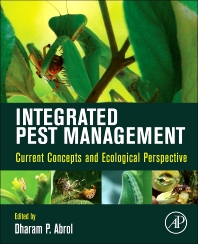Books in Agricultural and biological sciences
Books in Agricultural and biological sciences
The Agricultural and Biological Sciences collection advances science-based knowledge for the improvement of animal and plant life and for secure food systems that produce nutritious, novel, sustainable foods with minimal environmental impact. Food Science titles include not only those products from agriculture but all other aspects from food production to nutrition, health and safety, chemistry to security, policy, law and regulation. Biological Sciences address animal behaviour and biodiversity, organismal and evolutionary biology, entomology, marine biology and aquaculture, plant science and forestry.
- 1st Edition
- September 2, 2013
- Kathryn Bayne + 1 more
- English
- Hardback9 7 8 0 1 2 3 8 5 1 0 3 1
- eBook9 7 8 0 1 2 3 8 5 1 0 4 8

Laboratory Animal Welfare
- 1st Edition
- August 31, 2013
- Palmiro Poltronieri + 2 more
- English
- Hardback9 7 8 1 9 0 7 5 6 8 2 9 9
- Paperback9 7 8 0 0 8 1 0 1 5 3 6 0
- eBook9 7 8 1 9 0 8 8 1 8 4 7 8

From Plant Genomics to Plant Biotechnology
- 1st Edition
- August 31, 2013
- Bhesh Bhandari + 3 more
- English
- Hardback9 7 8 0 8 5 7 0 9 5 1 3 8
- Paperback9 7 8 0 0 8 1 0 1 4 1 6 5
- eBook9 7 8 0 8 5 7 0 9 8 6 7 2

Handbook of Food Powders
- 1st Edition
- August 28, 2013
- Dharam P Abrol
- English
- Hardback9 7 8 0 1 2 3 9 8 5 2 9 3
- eBook9 7 8 0 1 2 4 0 1 7 0 9 2

Integrated Pest Management
- 1st Edition
- August 16, 2013
- Stanislaw Brzychczy + 1 more
- English
- Hardback9 7 8 0 1 2 4 1 1 4 6 8 5
- eBook9 7 8 0 1 2 4 1 0 4 8 2 2

Mathematical Neuroscience
- 4th Edition
- August 9, 2013
- Robert L Zimdahl
- English
- Paperback9 7 8 0 1 2 8 1 0 0 0 6 6
- Hardback9 7 8 0 1 2 3 9 4 4 2 6 9
- eBook9 7 8 0 1 2 3 9 7 8 1 8 9

Fundamentals of Weed Science
- 1st Edition
- August 1, 2013
- Gerhard Schiefer + 1 more
- English
- Paperback9 7 8 0 1 2 4 1 7 1 9 5 4
- eBook9 7 8 0 1 2 4 1 7 2 0 2 9

Transparency for Sustainability in the Food Chain
- 5th Edition
- August 1, 2013
- R. Paul Singh + 1 more
- English
- eBook9 7 8 0 1 2 4 1 7 2 4 6 3

Introduction to Food Engineering, Enhanced
- 1st Edition
- July 31, 2013
- Paul Brereton
- English
- Paperback9 7 8 0 0 8 1 0 1 5 5 2 0
- Hardback9 7 8 0 8 5 7 0 9 2 7 4 8
- eBook9 7 8 0 8 5 7 0 9 7 5 9 0

New Analytical Approaches for Verifying the Origin of Food
- 1st Edition
- July 31, 2013
- Charlotte Jacobsen + 3 more
- English
- Hardback9 7 8 0 8 5 7 0 9 4 2 8 5
- eBook9 7 8 0 8 5 7 0 9 8 8 6 3

Food Enrichment with Omega-3 Fatty Acids